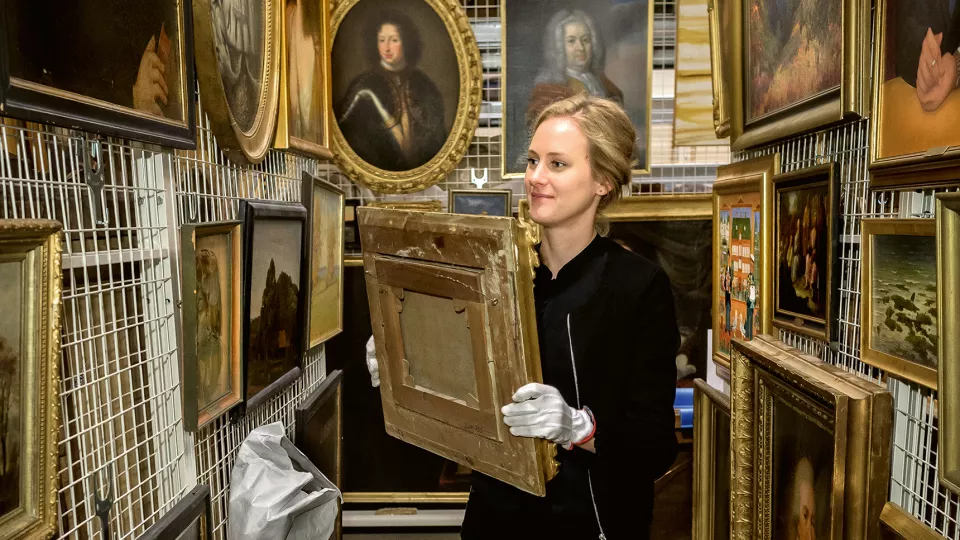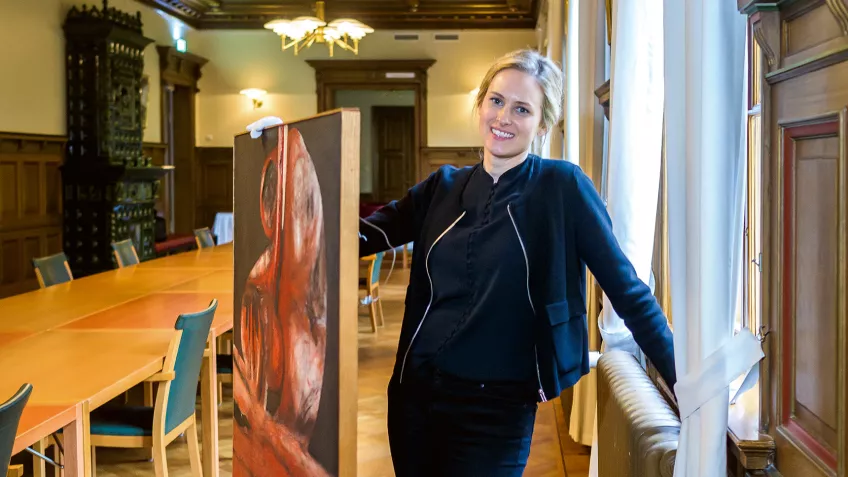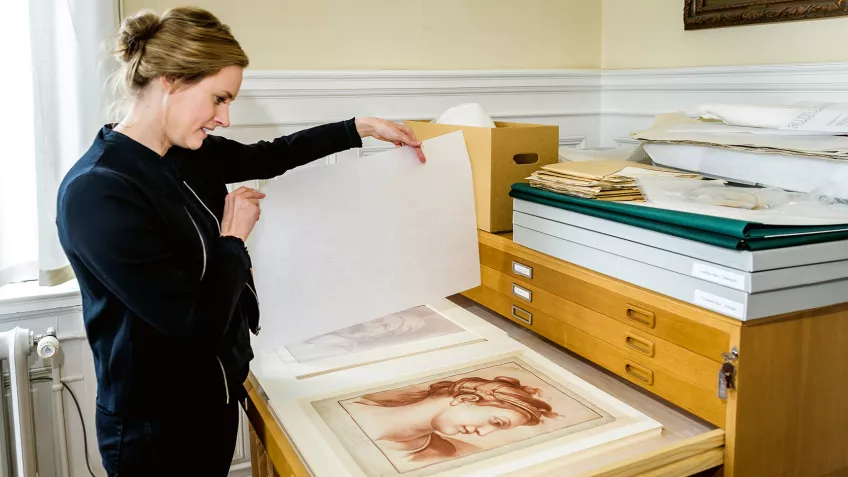Wearing white gloves, Annie Lindberg carefully lifts down a painting in the Old Bishop’s House and carries it through the 17th century room.
”Sometimes I avoid thinking too much about what I have in my hands, it can be worth millions of crowns”, she says.
Preserving the collection for all eternity
The walls are adorned with still life paintings of fruit, smooth peaches and grapes which seem to glow from within, and snow-covered landscapes against pink winter skies. All of them in gilt frames. Here and there are a skull or an insect crawling over the fruit. These elements were added to the painting to remind the beholder of life’s transience – the idea of life after death was a constant presence in the 17th century.
“There is something cool about the task of ‘preserving the collection for all eternity’, says Annie Lindberg.
She places the painting on the floor. In her many assignments around the University, she deals with art from the 1400s to the present day. There are around 3000 artworks in all styles. The collection is world-class, even though the quality of the art varies from Anders Zorn and Carl Fredrik Hill to mediocre paintings by unknown artists.
“Now I am working on getting an overview and planning the art for the King’s House and the main University building”, says Annie Lindberg.
Once the renovation of the King’s House is complete, paintings by Tora Vega Holmström will be hung there together with other modern artists. The art in the main University building will be similar to what it was previously: large, older, traditional paintings. On the third floor, the gallery will be restored according to architect Helgo Zetterwall’s original idea.
“Here we want to display temporary exhibitions from the University’s collection, interspersed with exhibitions from the Pictura gallery.”
Annie Lindberg currently has two jobs at once: archivist and acting director of Skissernas Museum – Museum of Artistic Process and Public Art, after Patrick Amsellem’s departure from Lund to become the head of the State Art Council. But she does not appear to be under pressure, saying instead that she is doing as much as possible with the resources available. She sees “When collections come to life” as a long-term passion project.
“The art collection is the University’s visual memory which tells its story. It feels wonderful to be in a position to take it on”, she says, carefully pulling out the drawer of an old filing cabinet in which portrait drawings lie in neat stacks.
A new open warehouse will be built
These particular drawings are well stored, but there is a risk that art kept in all possible spaces at the University could be damaged by humidity, mould or careless handling. It has therefore now been decided that art which is not on display around the campus is to be stored in a new warehouse. The warehouse will also contain the Skåne archaeological collections for which the Historical Museum is responsible. Its location has not yet been decided.
“It will be an open warehouse where the public, art students and school classes will be able to book tours”, says Annie Lindberg.
Once the new warehouse has an address, a fund-raising campaign to finance it will begin. But already today, there is a warehouse that cannot accept visitors. It is located at a secret address and LUM is allowed to accompany Annie Lindberg there, with the promise to keep the location secret.
“I would like to maintain a bit of mystery and there are valuable items here”, she says as she disables the alarm and opens the door to what looks like a hangar.
Inside, everything from human-sized cubist sculptures, rolls of drawings, large modern paintings and dozens of portraits are crammed in. You can almost hear the wings of history beating under the high ceiling. Usually Annie Lindberg cycles here and then works alone in the warehouse.
“I get a feeling of entering another world when I come here”, she says.
Although she is not completely alone. A huge, gilt-framed codgers’ parade of professors, vice-chancellors, kings and other bigshots gaze down upon us.
“I like to joke that they are my friends. Imagine if they could talk to me …”
The new warehouse is also to bring students and researchers in art history closer to the collection. And it is important for it to be a long-term solution.
“The art collection needs to find a home. The risk that artworks will be damaged or destroyed is greatest when they are moved”, says Annie Lindberg.






